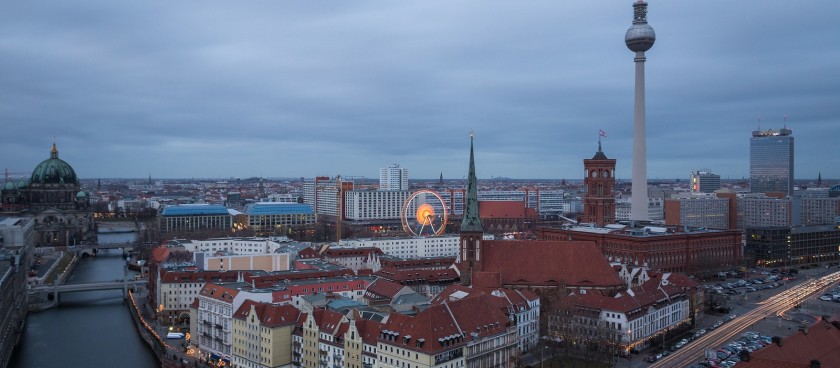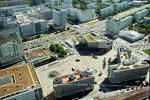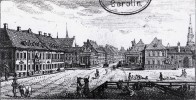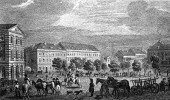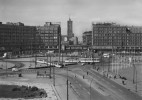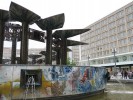- #DE30
- Alexanderplatz 1 10178 Berlin Germany
- info@berlin.de
- berlin.de
- 52.5219683, 13.4133275 Copy to clipboard Copy
-
#Family time
History
Alexanderplatz appeared in its modern form only in the 18th century, but its history back to the Middle Ages.
Terrain before the square laid.
Once upon a time, the place where the centre of Berlin located was located even outside the city walls. Around 1400, the most impoverished strata of the population began to settle here, and the place started to call "the garden of devilish pleasures" since there were also gallows nearby.
But Berlin grew. Soon, Alexanderplatz square was not far from the gates, on an important trade route along which goods from the Baltic countries went to the German capital. And at that time, such a flow of merchants meant only prosperity for the area through which it passed.
At this time, they traded cattle on Alexanderplatz, but when the square was inside the city walls, the law began to act on it, prohibiting the trade in cattle in the city. Instead of a livestock market in the square, the usual weekly market for the Renaissance started working.
Following the Thirty Years ' War, they decided to strengthen Berlin at the end of the 17th century. A drew up a topographic plan of the area, and the city walls captured the space within their perimeter. But land in the room was relatively cheap, which led to a sharp increase in the number of houses in the Alexanderplatz area. The buildings arose chaotically, which led to the appearance of a ban on construction in 1691, but by that time, 600-700 families already lived in the square area - mainly butchers and artisans.
The square sandwiched between the city walls and earthen ramparts, which formed its irregular shape.
In the 17th and 18th centuries, many important buildings located in the Alexanderplatz area of Berlin: a tower with city guards and a prison, a plague infirmary, a hospital, an orphanage, a tavern, etc.
Later in the 18th century, built several large textile factories in the square area, and the composition of the local population changed. The room began to be populated by petty-bourgeois, retired soldiers and factory workers. The court itself also rebuilt and dismantled the city walls. But the market continued to operate on Alexanderplatz, which joined by a significant annual wool fair.
Foundation of the modern square
On October 25, 1805, a meeting held on the square between Alexander I and Frederick William III, King of Prussia, who was waging war against Napoleon, having concluded an alliance that later became the Third Anti-French Coalition. The war ended unsuccessfully, the Holy Roman Empire ceased to exist, but the name of the square has remained to this day.
Throughout the 19th century, Alexanderplatz was rebuilt and made into a more familiar form of culture and entertainment rather than an industrial and commercial place. In 1823 a theatre was built; in 1847, flights to Potsdam began regularly from the square in the 70s, the city moat filled up for making a railway, and towards the end of the century, a police building and a court appeared here.
XX century
At the beginning of the century, the first shopping centres (department stores) began to appear on Alexanderplatz, and a lounge appeared. The role of the square as a transport hub also sharply increased: the metro, electric (and before that, horse-drawn) trams appeared. The development of private transport led to traffic jams, and in the 1920s, an architectural competition held to rebuild Alexanderplatz. But the winning project was not fully implemented, privately owned like most of the land and buildings, and their ransom could not pay by American investors who suffered during the Great Depression.
In 1936, city traffic monitoring showed Alexanderplatz to be Berlin's busiest square.
During the Second World War, the square and surrounding buildings badly damaged during the city battles in Berlin. Many buildings destroyed, the Berlin subway flooded, in which German soldiers were hiding.
Immediately after the war, the destroyed central square was a marginal place where a spontaneous barter market operated. In the 50s, Alexanderplatz restored, and in 1964 made a decision on a global reconstruction and announced a new competition; the implementation of the winning project began in 1966. As a result, traffic flows were diverted directly from the square, expanded, and demolished and rebuilt many buildings. A vast skyscraper hotel, several state buildings and the Fountain of Friendship of Peoples appeared near Alexanderplatz, which still adorns the square.
The size of the area best indicates the nature of the changes. Before the war, Alexanderplatz occupied 18,000 square meters, and after reconstruction - 80,000.
Also in those days, the Berlin TV Tower appeared, which located near the square and today is the best visual landmark in the city.
Our days
Various changes to the square structure made regularly, but another global project started in 2004, after lengthy approvals and competitions that have been going on since the 90s. In 2005, rebuilt the former Centrum department store and in 2007, opened the Alexa shopping centre and ample underground parking.
Further plans for modification of Alexanderplatz include constructing skyscrapers around the square and instead of the 120-meter Park-Inn hotel. There are no investors for most of the ideas; only known that in 2017 it is planned to build a 39-storey residential building, which will house 700 apartments and a hotel.
Area
Almost all Berlin tourists visit Alexanderplatz, often not even including the square in their route, but several branches of all kinds of transport converge city trains, trains, trams, subways, buses.
Near the square is the station of the same name, where the city trains S-Bahn stop, and three metro lines converge under the court: U5, U8 and U2. All this combined into a single interchange hub. But rail transport on the square is also represented by trams, which Berlin inherited from the GDR.
Driving past Alexanderplatz, you shouldn't miss this Berlin landmark. The area is tourist, lively and exciting. For visitors, there are souvenir sellers, cafes and other entertainments. But most importantly, the spirit of the GDR is very much felt here, a mixture of styles and cultures of two Germany, western and, close to us, eastern.
Some of the buildings on the square may seem familiar to the residents of the CIS; these are, first of all, three Houses: Travel, Industry and Teacher, made in the style classic for the socialist countries. They have turned into ordinary offices, but they recognized as architectural heritage, and their appearance has been preserved almost in the original.
Shopping lovers will be interested in the Galeria shopping centre, the former Centrum department store. It houses many shops with branded clothing from major international and German companies.
Also on Alexanderplatz, there is a skyscraper of the already mentioned hotel, which today is called "Park Inn". But it cannot say that the building is impressive - against the backdrop of New York skyscrapers, the hotel fades, and besides, it is not even the tallest hotel in Berlin. Although short, the authorities want to surround the square with high-rise buildings, creating a business conglomerate in the centre of Berlin.
The TV tower looks much more interesting, not located on Alexanderplatz, but a little to the side - near the station. The futuristic building, 368 meters high (along with the spire), can be seen from almost every part of Berlin. There is also an observation deck available for everyone on the tower.
But on Alexanderplatz street, there are two more architectural objects: a fountain and a clock. The "Peoples' Friendship Fountain" was built in 1970, its height is more than 6 meters, and its diameter is 23. In 2007, its reconstruction completed. And the clock is a rather unusual monument, named "Urania", showing the world time. The dial is horizontal and rotates against the background of stationary names of cities. The sculpture decorated with parade planets a dial located on a leg, which stands in the centre of the wind rose.
For its brightness, great use of mosaics and glass, the fountain was popularly called the "prostitute's brooch".
